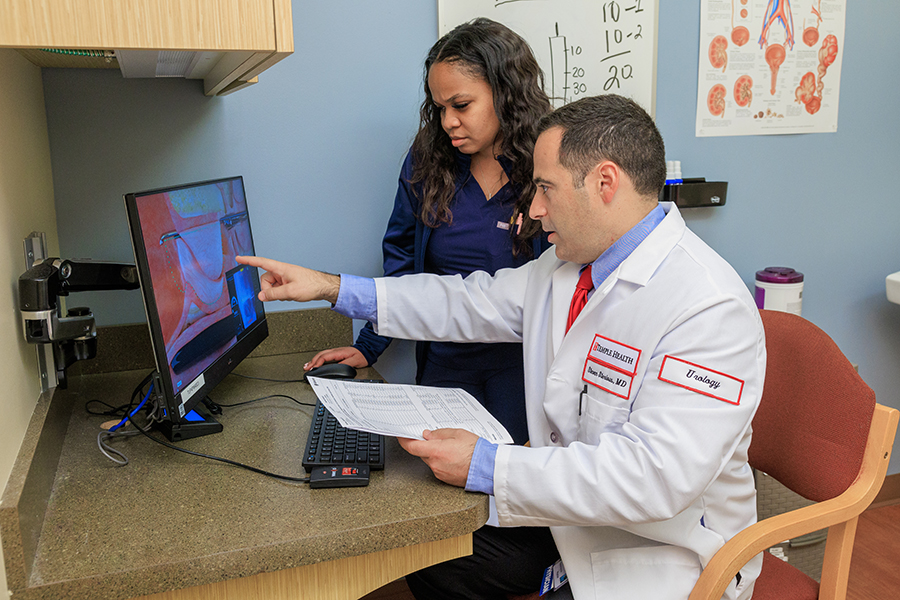This Philly Doc Uses Water Jets and Robotics to Shrink the Prostate and Improve Sleep and Sexual Function

There are few surgeries more challenging than prostate surgery, and few that can be more sensitive, and potentially scary, for patients. And yet many older men will face a common condition for which prostate surgery can be the most effective solution: 50 percent of men over 50 will experience benign prostate hyperplasia (BPH), an enlargement of the prostate that can cause a loss of control over urination.
Effective surgery for the condition can be transformative, but a wrong approach can carry large consequences. If treatment is too conservative, it can fail to solve or offer only a temporary fix to limiting or even debilitating problems with urination, which can inhibit freedom of travel and of public life.
“Patients tell me their stories about how it affects their quality of life–One of my patients couldn’t drive to the Jersey shore, three hours away, without knowing each and every rest stop,” says Dr. Steven Sterious, urologist at Temple Health who specializes in robotic surgery. “Another couldn’t golf because they had to run to the trees between each hole.”
However, if surgery goes too far in removing tissue, it can instead permanently damage sexual function. Many prostate surgeries carry these risks no matter the skill of the surgeon, which makes for a very difficult choice for patients when considering solutions that lean toward one risk over the other.
“Looking at previous technologies, there wasn’t an option that let you avoid a difficult choice, where you’d either have to have repeated procedures or suffer potentially permanent side effects,” says Sterious.
It’s a big challenge, but a fascinating new approach to the surgery called aquablation aims to minimize downsides while maximizing the upsides. It brings together some of the most important innovations in contemporary surgery–a surprising combination of concentrated blasts of water (also known as hydrodissection), ultrasound-guided planning, and robotic technology–to lower the risk for both sexual and urinary function. In the process, it’s setting a new standard for prostate surgery.
Removing the Difficult Choice
The surgery is promising a new kind of life for those entering their golden years, according to Sterious, who was the first doctor to bring the technology to Philadelphia.
“You get the best of both worlds,” says Sterious. “Lower risk of sexual side effects, without the need for repeated procedures.”
Sterious became interested in the technology after years of working with treatments that fell mainly into two categories, characterized by one significant choice. On one hand, avoid sexual side effects through minimally invasive treatments, and have to get treatment again in a few years. On the other, choose to clear away tissue more permanently, and risk loss of feeling and function. It was up to the patient and their lifestyle.
“Say if a patient is 75 and widowed and hasn’t been sexually active in five years, he might just want to sleep through the night without having to go to the bathroom,” says Sterious. “If he’s 55, married, and his kids have just left for college, ensuring sexual function might be more important to him.”
When Sterious learned about the development of the aquablation technology, and looked at the numbers, he saw that you could get something close to the permanence of major surgery with the low risk of something minimally invasive.
“Aquablation has a 6 percent chance of requiring either medications or another procedure in the next five to six years, while with [a common minimally invasive treatment], the odds range from 15 to 33 percent depending upon the technology,” Sterious says. “On the other hand, the risk of sexual side effects in resective procedures can be anywhere from 30 to 80 percent, but aquablation is 10 percent.”
A Culmination in Surgical Innovation
The key to getting those results is multifaceted. One, aquablation takes advantage of recent innovations in the use of ultrasound in preparing for surgery. Prostates can be so unique from person to person, that removal of tissue without having a full understanding of that individual prostate can be a matter of going in blind to some extent. The ultrasound allows Sterious to plan his approach.
“In the same way that everyone has a different fingerprint, everyone has a different prostate,” Sterious says. “The ultrasound allows us to map out the prostate, so we can look and say we’ll leave this tissue because it provides a benefit and won’t cause much of a problem, but we’ll eliminate this bit of tissue over here.”
That plan is carried out with more-than-human precision thanks to the use of a robotically controlled handpiece that is guided by the ultrasound. As for the use of water, it comes through a kind of small, concentrated hose that carries away tissue from the prostate, allowing for further precision that avoids unnecessary tissue damage.
“It’s great because now I can also calculate how long the procedure will be with a fair amount of consistency. That could be anywhere from 20 minutes with small prostates to a little over an hour for large ones,” Sterious says. The control that the tech affords also makes recovery quick and predictable–some patients can go home the same day.
Sterious says that patients now tell him that they feel free to make a decision to increase their freedom and mobility without feeling like they’re giving up sexual function–from beach trips to golf and more.
“I have patients that are getting help that didn’t realize it could be an option for them,” Sterious says. “And they’ve told me that they are able to, for example, take that three-hour drive to the beach now. You hear these kinds of stories, and it makes you smile to know that you’re having an impact on someone’s life.”
This is a paid partnership between Temple Health and Philadelphia Magazine
